
by Dr Manjir Samanta-Laughton | Jan 13, 2021 | Paradigm Revolution, Punk Science, Science
Despite the fact that The Black Hole Principle has successfully predicted many aspects of the universe and solved some major problems in astrophysics, some mainstream scientists may still have some hurdles to get over before taking the theory on board. In this article, we examine three barriers to The Black Hole Principle.

1. Consciousness is Fundamental to the Universe
The Black Hole Principle actually rests on the concept that consciousness is fundamental in the universe. This explains why we are unable to see beyond the Perception Horizon.
The light beyond this barrier represents vibrations of consciousness that are beyond what we call the speed of light which is beyond our normal perception. I am saying that this is the region of dark matter and dark energy.
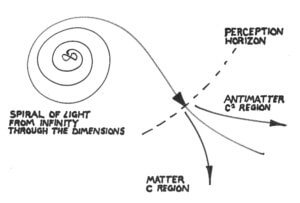
Consciousness as fundamental is a conclusion that some physicists have made about Quantum physics that solves the so-called measurement problem – that the wave-function collapses into a point particle when we measure it. Some physicists have concluded that consciousness is therefore fundamental to the universe.
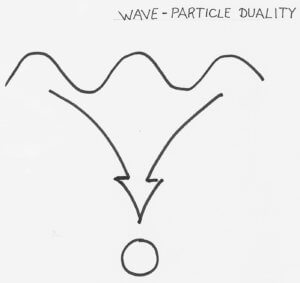
This is what The Black Hole Principle is also predicated on, that there are many levels of consciousness to the universe and we usually are only aware of what we call 3D.
2. The Speed of Light is not the limit of the Universe
I have just mentioned it but another hurdle is that The Black Hole Principle says that what we call the speed of light is not the limit of the universe and in fact, Einstein said that nothing with mass can go faster than the speed of light.
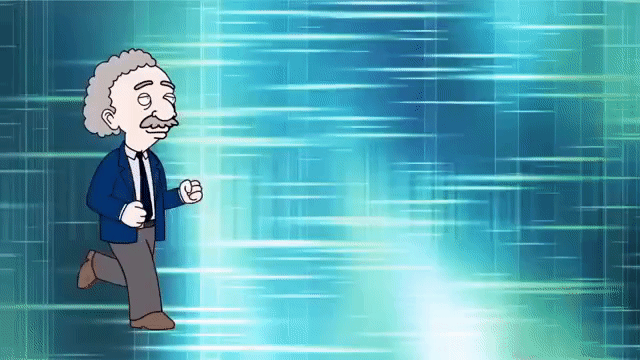
That is still correct. The speed of light renamed the Perception Horizon, is the point where the light coming from the centre of the black hole becomes matter.
Because mainstream scientists don’t understand that there are vast worlds beyond the speed of light, it makes it difficult for them to understand how massive releases of energy can occur such as in Fast Radio Bursts.

But when you understand that beyond-the-speed-of-light processes are coming into areas below the speed of light, it makes more sense.
3. It’s coming from outside of physics
Another hurdle is that The Black Hole Principle is coming from outside the scientific establishment. Although scientists such as theoretical physicist, Neil Turok admit that they are running out of ideas, they are still not open to them coming from outside of academia even if these ideas do solve their problems.
I am a medical doctor, not a physicist and I believe it is because I am not too attached to the mainstream narrative that the theory came to me in the first place.
In Punk Science TV, I have been highlighting lots of the issues facing modern astrophysics and the findings that don’t fit their theories. As this data comes flooding in, maybe we will see a change and mainstream scientists can get over these hurdles to embrace The Black Hole Principle.
Can you think of any more hurdles they might have? Please comment below this video. Thank you for watching and hope to see you next time.

by Dr Manjir Samanta-Laughton | Jan 6, 2021 | Paradigm Revolution, Punk Science, Science
We have already discussed the Gamma-ray bubbles in the Milky Way, now scientists have discovered bubbles made of X-rays. Although these pose a puzzle to current science, in this episode of Punk Science TV, we explain how the X-ray bubbles are created by The Black Hole Principle.
Gamma-ray bubbles found by Fermi
In 2010, the Fermi telescope found gamma-ray bubbles in the Milky Way either side of the central black hole. On the further resolution of the initial image, two concentrated jets could be seen.
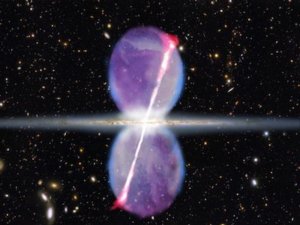
Credit NASA Goddard
At the time, scientists said they had no idea what was actually causing these gamma-ray bubbles. Even the person who found them said that it kind of just confuses everything. This is because mainstream scientists were not actually expecting to find such powerful emissions seeming to come from the central black hole of our home galaxy.
More bubbles found – X-rays this time
To make matters worse for mainstream scientists, people have now found some more bubbles but this time these are X-ray bubbles. These new findings have been published in the journal, Nature which reports how these new bubbles extend even further than the gamma-ray bubbles that were previously found.
This is very puzzling and is leading to headlines such as ‘Our galaxy is blowing enormous hot bubbles into space and no one knows why.’

Bubbles explained
But that’s not entirely true, because if you are aware of The Black Hole Principle, you’ll expect black holes to give off bipolar jets.
The Black Hole Principle says that light comes from infinity, through the dimensions to our dimension, then splits into matter and antimatter and combines again into light at that Perception Horizon that’s actually at the speed of light.
That combination into light is actually most commonly in the form of a Gamma-Ray burst. Because the Black Hole Principle occurs at every level of the universe, the type of light that is produced can vary.

The Black Hole Principle
Two poles of X-rays from fast-moving electrons
The ‘breathing’ process in the Black Hole Principle that creates matter and antimatter occurs just below the speed of light. The matter that is produced can often be in the form of electrons. This means that the electrons have only just ‘slowed down’ to below the speed of light.
This is what we see through our telescopes; we see fast-streaming electrons coming from black holes and indeed from every level of the universe. We even see this happening in the thunderstorms above our heads. Fast-moving electrons can result in X-rays.
The Black Hole Principle gives off a pattern of intermittent gamma rays and X-rays as the black hole is ‘breathing’ in and out. These emissions often take the form of two jets at 180 degrees to each other.
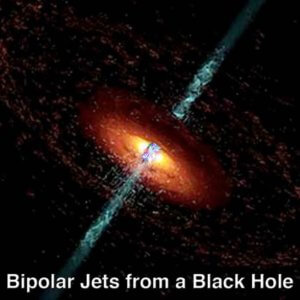
Bubbles predicted
And so that’s why, with knowledge of The Black Hole Principle, we would expect there to be two poles of emissions either side of this galaxy. The bubbles are being created by the bipolar jets of gamma rays and X-rays, which are spiralling and rotating.
Bubbles have also been spotted around other objects such as stars. When you start looking, you can find many examples of bipolar jets and even bubbles around various structures in the universe.
So according to The Black Hole Principle, this is the explanation for why X-ray bubbles are appearing in the Milky Way.
What are your thoughts on why the galaxy is blowing bubbles? Please leave your comments below.

by Dr Manjir Samanta-Laughton | Dec 30, 2020 | Paradigm Revolution, Punk Science, Science
Volcanoes are supposed to be hot, so why are cold volcanoes found all over the solar system? In this article, we are going to be exploring Cryovolcanism.
Hot vs Cold
You are probably aware of volcanic activity on Earth – Volcanoes spew hot lava which is molten rock and various gases. It is believed that heat is part of the mechanism of why volcanoes occur. So why is it that ice-cold cryovolcanoes are being found in various part of the solar system? How can volcanoes be cold?
Not only does cryovolcanism exist but we are finding it throughout the solar system. The dwarf planet, Ceres was expected to be a boring, inactive lump of rock. But instead, we found cryovolcanoes on Ceres as well as on Titan, which is one of the moons of Saturn and also on Pluto.
Pluto is really far out from the sun and so we expect it to be extremely cold, frozen and inactive. So the volcanic activity on Pluto was a bit of a surprise.
Do we really understand volcanoes?
It may all come down to the fact that we have mistaken what volcanoes are in general. We think we know how volcanoes work on planet Earth. But if you look closely, you will see that people who study these things don’t really know exactly why volcanoes happen. This issue of Geographical magazine contains an article that admits that we don’t even know the basics of how volcanoes work.


So it’s a bit of a misnomer to say that we know exactly why volcanoes happen on Earth, let alone cryovolcanoes in space.
Commonalities in eruptions
I think we should look beyond individual types of eruptions to a single mechanism that unites them all. What I’m saying is that eruptions and volcanoes are all expressions of the same principle: The Black Hole Principle.

The Black Hole Principle
If you remember, The Black Hole Principle says that light comes in from higher dimensions and then splits into matter and antimatter and these combine again to form light. So you have these intermittent eruptions of energy and particles.
We have also looked in previous episodes at how The Black Hole Principle creates water and even substances that we normally call ‘fossil fuels’ such as methane.
And that’s indeed what we see coming out of these Cryovolcanoes: methane, water, and ammonia.
In fact, we actually see water vapour coming out of volcanoes on Earth as well. In another previous episode, we looked at how stars actually emit water bullets.
Transcending the eruption
This is what I’m putting forward, that we have to transcend this concept of a volcanic eruption of ‘stuff’. The energy starts out in a different dimension and comes through and expresses itself at every single level of the universe.
So whether that be a hot planet or a cold planet, the energy is the same. The principle is the same. The Black Hole Principle is creating volcanoes at every level that we see them. Cryovolcanism is to be expected because all these planetary bodies are working in the same way just at different scales and temperatures.
Predictions and Conclusions
We not only expect to see more eruptions happening in our own solar system but even beyond our solar system because they are caused by a universal principle.
I hope that’s explained a bit more about cryovolcanism and volcanism in general, if you’d like to see more, please subscribe below and leave a comment to let me know what you think.

by Dr Manjir Samanta-Laughton | Dec 23, 2020 | Punk Science, Science
Auroras on a comet?
A lot us are familiar with the concept of Northern Lights and Southern Lights or Aurora Borealis and Australis as they are otherwise known. But why have scientists spotted an aurora on a comet? They are also seen around moons and other planets. Is the received wisdom on Auroras correct and what do they have in common with Black Holes? These are the questions we are asking today: what is the connection between auroras, comets and black holes?
A spectacular light show
You may be familiar with the concept of the Northern Lights which are spectacular changing colours that are sometimes seen in the sky in countries close to the North pole.
We are told that this spectacular light show actually has its origins with the sun as the solar wind, consisting of fast-moving charged particles, interacts with the magnetosphere of our planet causing various elements in the Earth’s atmosphere to create the colours that we see.
And for many years, we have accepted this explanation. Except as space exploration continues, we find some anomalies that don’t fit this theory. Auroras are seen on planets that we previously supposed were not able to have them. Jupiter has an aurora that is deemed too powerful for this usual explanation.
And in 2020 scientists discovered that even comets have auroras! This particular aurora was in the ultraviolet aspect of the spectrum so invisible to us.
But it leaves us with the question; how is it possible that something as small as a comet can generate a magnetic field large enough to interact with the solar wind and generate an aurora? The same question arises when we find auroras on distant moons too.
What exactly is going on?
Northern and Southern Lights pulse at the same time
I find it really intriguing that the northern and southern hemispheres on the earth both have these auroras at the same time – they are known as the Aurora Borealis and Aurora Australis respectively.
Actually, rather than coming from the outside in as we would expect particles from the sun to do, the charged particles go from the middle to the poles and you see both the northern and southern hemisphere light up at the same time. Not everyone mentions this and most of the diagrams show the particles going the other way.
In other words, the charged particles that create auroras on the Earth are similar to bipolar jets that we see around black holes.

Even though they are supposed to be created by different mechanisms, we see auroras around planets and moons and they consist of fast-moving charged particles.
A new theory of Auroras – they are bipolar jets!
I think that auroras are an expression of The Black Hole Principle: the same mechanism is happening in black holes in space as on the earth and also many bodies throughout space as well.
So you have these poles of charged particles that are going from the centre to either side, going to the north and the south poles of the earth.
The fast-moving charged particles, such as electrons, are creating these northern and southern light shows that we see with the interactions with the elements of the atmosphere.
But it’s not the just the solar wind interaction, it’s the interior of Earth or whichever planetary body, whether that be a moon or a comet, Jupiter or anything else that we’re finding that has auroras, it’s all the same sort of mechanism.
If we put it that way, then we’re looking at auroras are caused by bipolar jets of fast-moving charged particles similar to those found in black holes.
The Black Hole Principle and Auroras
We can see auroras as an expression of the Black Hole Principle. That’s what I think is also happening with the auroras that we’re seeing around comets.
We know that black holes create jets of fast-moving electrons due to The Black Hole Principle. These are powerful and intermittent and often are emitted in jets.

The Black Hole Principle
I think the same mechanism that creates auroras around comets is actually creating auroras at every single level, be it Jupiter or the Earth or moons. It‘s these bipolar jets that we see in black holes that are creating the auroras around planets and various bodies.
I hope you found this article and TV episode on Auroras, Comets and Black Holes interesting. Please leave your comments below and let me know what you think.

by Dr Manjir Samanta-Laughton | Aug 12, 2020 | Punk Science, Science
What creates Saturn’s rings?
Did you know that scientists still don’t know what created the rings of Saturn?
In this episode, we look at the data from the Cassini probe to see if it can shed light on this enigma.
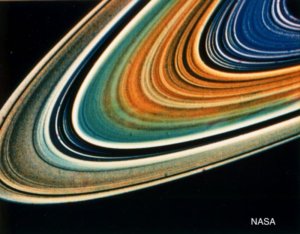
A cosmic mystery
First spotted by Galileo, Saturn’s rings are a source of fascination for human beings. So it seems strange that after all this time, we still don’t know how they were created.
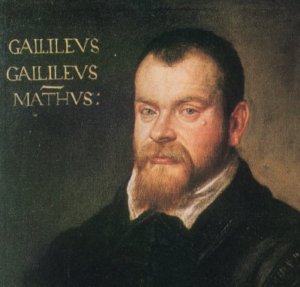
Galileo was thought to have first viewed Saturn’s rings
Cassini’s mission
Thanks to the Cassini missions we have now visited Saturn’s rings and found a few more details.
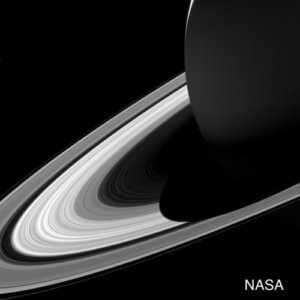
Because the rings are very bright and reflective, scientists have concluded that they are younger than the planet Saturn itself because there hasn’t been enough time for dust particles to decrease this reflectivity.
Was it a collision?
One of the best explanations that scientists have come up is – a collision! Yes, just as in previous examples discussed on this site, when they don’t have an explanation for an observed phenomenon they conclude that it is a collision or an explosion.
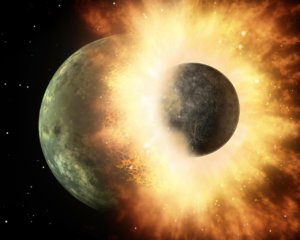
12019 / Pixabay – Planetary Collision
Can the Black Hole Principle provide the answer?
According to The Black Hole Principle, creation is happening at every single level coming in from infinite light all the way through to our reality below the speed of light.

The Black Hole Principle
As I have said on this site many times before, this also creates water and organic compounds such as methane.
It woz Saturn!
So the short answer is Saturn itself is creating the rings. Just as a black hole in a galaxy creates spiralling material.
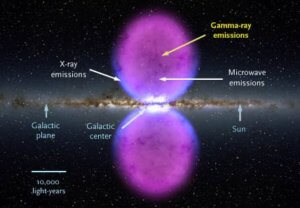
Jets from the Milky Way create gamma-ray and X-ray bubbles Credit: NASA
Saturn also is a black hole that creates water which then freezes. We have discussed before how The Black Hole Principle creates water and Saturn is no different.
The organic material created by The Black Hole Principle process within Saturn is why the inner rings have more organic material than the outer before it dissipates and also why the rings are moving so fast – this is material being ejected from Saturn.

Saturn’s spiralling rings
The Geometry of Creation
So why doesn’t every planet have rings? Each level of the Black Hole Principle expresses itself differently. It is all part of the one ultimate spiral of light – so each particle and planet is just somewhere on the spectrum of this one ultimate spiral.
What determines how it will behave? Geometry!
And if you have any doubt that geometry and mathematics are fundamental to the universe – just look at Saturn’s Hexagon at its pole.
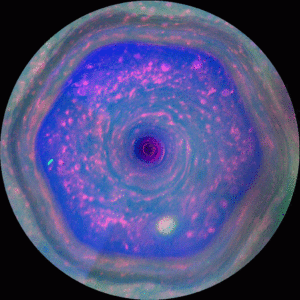
Geometry causes each level to behave in a different expression of the one pattern. In the case of Saturn, the underlying geometry creating it is beautifully staring at us.
I hope you found this episode of Punk Science TV and the article interesting. Please leave a comment below and tell me what you think

























